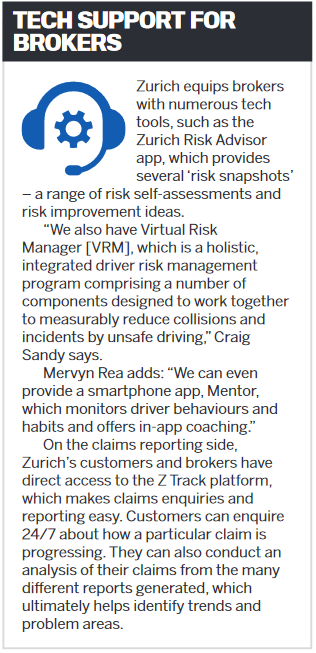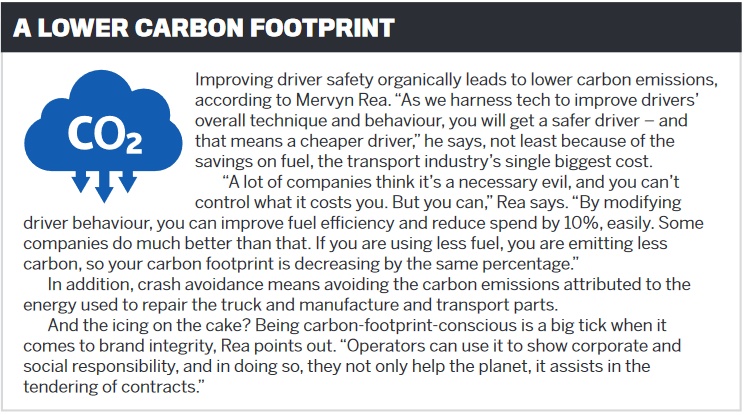

Fast-forward a few years – three, five, maybe 10. You’re a truck driver, but it would be more accurate to call you a software engineer. Because you’re not actually driving; you’re in the cab to intervene if something goes wrong or to take over when the vehicle’s sensors are unable to handle less-than-ideal conditions like roadworks or a residential street on rubbish collection day.
While some might think this is the automated vehicle of the future, it’s already here and going through trials. This technology is just one way that innovation will revolutionise the transport sector. And it’s some-thing Mervyn Rea, Head of Zurich Resilience Solutions, is immensely excited about.
“Zurich Resilience Solutions is a newly created unit that contains our Risk Engineering function and is focused on servicing customers and our underwriters with risk management support,” Rea says. “We need to embrace technology – we know driverless trucks, for example, will happen, and if we can influence and control the technology, I’m happy to be an objective contributor to that.”
Rea sees constantly pushing the boundaries of innovation as key to improving driver safety, lowering the sector’s carbon footprint, boosting operators’ profit margins, professionalising the role of a truck driver (thereby tackling a critical skills shortage) and getting around the raft of problems associated with supply chain disruption.
The shortage of drivers is an ongoing concern for the transport sector, exacerbated by the fact that many insurers won’t cover drivers under the age of 21. But a positive byproduct of technology aimed at making the job safer is an upskilled role that’s more appealing to a new generation, Rea says.
“Where younger drivers are proficiently trained and licensed, you can, to a degree, offset that lack of experience thanks to things like telematics, where we are seeing greater uptake and continual improvements in the tech itself. Young drivers can be monitored, which will allow for ongoing improvement and coaching. In the past, where customers have used well-proven technology that’s been backed up by a training program, we have reduced the young driver excess as a financial relief and as an encouragement to employers to consider younger drivers.”
 Craig Sandy, Zurich’s National Underwriting Manager for Motor, identifies additional challenges, such as keeping pace with legislative changes (like the Chain of Responsibility laws that came into effect in 2018), incorporating and maintaining a safety and sustainability culture, and managing and improving fuel cost efficiencies. But again, technology is a sound ally in combating these issues.
Craig Sandy, Zurich’s National Underwriting Manager for Motor, identifies additional challenges, such as keeping pace with legislative changes (like the Chain of Responsibility laws that came into effect in 2018), incorporating and maintaining a safety and sustainability culture, and managing and improving fuel cost efficiencies. But again, technology is a sound ally in combating these issues.
“Telematics, advanced driver assistance systems and semi-autonomous technology will all help,” Sandy says. “Telematics enables customers to closely monitor behaviour around harsh braking, harsh cornering, speeding and the like. The data can be used to better educate drivers, which will improve safety, reduce wear and tear, save on fuel, and reduce the time vehicles are off the road. These factors will ultimately improve productivity and save the customer time and money.”
Another challenge is the extra complexity of international and domestic border controls, which has resulted in congestion and delays, with major disruption to delivery timings and new challenges in meeting fatigue legislation. For the first time ever, Rea says, Australian transport is experiencing a “Brexit-like effect”.
“Disruption occurs, we modify, and it gets disrupted again,” he says. “There’s this continual change culture. We are getting more adept at rapid and repeated problem-solving.”
Add in an increasingly complex supply chain, and the plot thickens. But smarter tech can also help foresee – and therefore mitigate – some of the complexities.
“Supply chain risk management tech can source data from a number of independent sources, so we can see when an event might occur like a dockyard strike or a major storm,” Rea says. “We have partnered with Risk Methods, who have a software solution that helps bypass disruptors to the supply chain.”
With disruption becoming the norm – and drivers potentially forced to take unfamiliar routes or spend hours on congested roads – technology plays an increasingly pivotal role in taking pressure off drivers and keeping them safe.
“You can use cameras as post-incident ways of identifying if the driver has been fatigued or distracted,” Rea says. “But you also have Seeing Machines technology to constantly scan the face and eyes that can detect with pinpoint accuracy the onset of fatigue. That will generate an alert to keep the driver focused. Every driver wants to get home safe at the end of their shift. So, if we can prevent them from even a moment of distraction and fatigue that could lead to a crash, that’s great.”
Such monitoring technology has had positive uptake. A decrease in fatigue-related accidents not only gets drivers home safe to their families, but also reduces large loss incidents, thereby keeping vehicles on the road.
“This has meant improved productivity and profitability for many operators,” Sandy says. “Ultimately, improved incident ratios will give insurers confidence to continue to offer viable insurance solutions, and they will lead to a reduced insurance spend for operators.”
A lower insurance spend and increased productivity mean operators can reinvest in technology – something Zurich’s risk engineering team can help customers navigate. Sandy and Rea say operators can see cost and time as obstacles to implementing technology – but the Zurich team is there to assist in getting the best outcome.
“We can guide them and work with them, saving time,” Sandy says. “If customers are receptive to deploying driver-assist technology, this will be shown within our risk engineering assessment grading, which will assist with exposure pricing.”
When it comes to telematics, for instance, it’s not about identifying the best product – it’s more a case of ‘here is the absolute minimum outcome you want to get from this service’, Rea says.
“We are helping our customers get the biggest return on their risk management investment. For example, what will be the most efficient, most rewarding solution to reduce the frequency and severity of crashes? A better solution means a more sustainable, correctly priced risk premium, and there are also fuel savings and a reduction in uninsured costs.
“For every dollar of an insurance claim we pay, at a conservative estimate, there is sometimes $3 worth of uninsured losses: downtime, the excess on your policy, absenteeism from work, wages, vehicle finance. If you’ve leased the trucks, you don’t get a leasing holiday while the trucks are off the road, and truck repairs are taking longer because of COVID-19-related disruptions. If you can avoid a crash, you are avoiding all that additional, uninsured financial cost. That educational component is something we’ve been working hard at with our customers. We’ve even now got a free online ‘total cost of crash’ calculator.”
Rea leads a team of risk engineers who can assess the operational risk of a fleet. “We can show a customer what the risk profile is now and what the risk would be if they implemented a series of identified improvement actions,” he says. “Our underwriters are able to reflect this in the premium if the risk profile score is good or excellent. All we are doing is recognising existing good practice.”

All of this technology is available right now – but what about those driverless trucks?
“Zurich, globally and locally, has been involved with autonomous vehicle trials, so it is certainly on the agenda,” Sandy says. “The world is rapidly evolving and heading straight for this technology.”
There are still many concerns to tackle, including cybersecurity, software and maintenance, road conditions, government/legislation, cultural shifts, and insurance/liability. However, Sandy says Zurich Australia sees participation in such trials as critical.
“Understanding the risks and exposures well before it becomes common in society will secure our position as a market leader in the motor fleet space,” he says.
Rea acknowledges it will take time to iron out the kinks and master the technology. But whether it’s autonomous vehicles, telematics or anything else, innovation is here to stay – which can only be a good thing for the transport sector.
